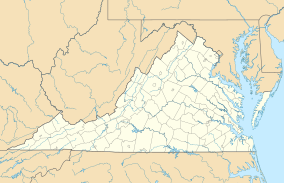| Conway Robinson State Forest | |
|---|---|
IUCN category VI (protected area with sustainable use of natural resources) | |
 Conway Robinson State Forest in autumn | |
| Location | Prince William County, Virginia |
| Coordinates | 38°48′12.6″N 77°35′16.7″W / 38.803500°N 77.587972°W |
| Area | 444 acres (180 ha) |
| Established | February 1938 |
| Governing body | Virginia Department of Forestry |
Conway Robinson State Forest is a state forest in Prince William County, Virginia, near Manassas National Battlefield Park. It serves as a wildflower and wildlife sanctuary. The forest covers 444 acres (180 ha) of pine plantation, mixed pine, and old-growth hardwoods and is one of the largest tracts of undeveloped land owned by the Commonwealth in Northern Virginia.[1]
History
[edit]The Conway Robinson State Forest was named after Conway Robinson, a 19th-century lawyer, historian, and author from the Commonwealth of Virginia. He is most famous for having argued approximately 100 cases before the Supreme Court of the United States and being a founding member of the Virginia Historical Society. The Conway Robinson Park Memorial Association sought to perpetuate the memory of him as a distinguished Virginian through the development of a state forest, which was eventually established in February 1938.[1]
Description
[edit]The Conway Robinson State Forest is owned and maintained by the Virginia Department of Forestry. Forest management activities include tree planting and harvesting, as well as actions to enhance water quality, aesthetics and wildlife. Management is guided by the original deed, which limits tree removal except for the improvement of the forest's resources and habitat. In addition, the forest provides space for research projects by college or university students, tours and demonstrations, and other educational activities.[1]
Public use and access
[edit]The forest serves as a recreation area with various uses. It features approximately 5.1 miles (8.2 km) of multi-use trails, which may be used for hiking, mountain biking, trail riding, and geocaching. The forest is open to the public for recreation activities during daylight hours. Camping and motorized vehicles are prohibited.[1]
A State Forest Use Permit is required for visitors aged 16 or older to ride horses, ride mountain bikes, hunt, and trap. A State Forest Use Permit is not required for those using the forest for walking or hiking. A valid Virginia hunting license in addition to a State Forest Permit is required for hunting or trapping within the forest.[2]
See also
[edit]References
[edit]- ^ a b c d "Conway Robinson State Forest". Virginia Department of Forestry. Retrieved April 11, 2017.
- ^ "Virginia's State Forests". Virginia Department of Forestry. Archived from the original on May 18, 2017. Retrieved April 11, 2017.
External links
[edit]


Well, that’s interesting to know that Psilotum nudum are known as whisk ferns. Psilotum nudum is the commoner species of the two. While the P. flaccidum is a rare species and is found in the tropical islands. Both the species are usually epiphytic in habit and grow upon tree ferns. These species may also be terrestrial and grow in humus or in the crevices of the rocks.
View the detailed Guide of Psilotum nudum: Detailed Study Of Psilotum Nudum (Whisk Fern), Classification, Anatomy, Reproduction